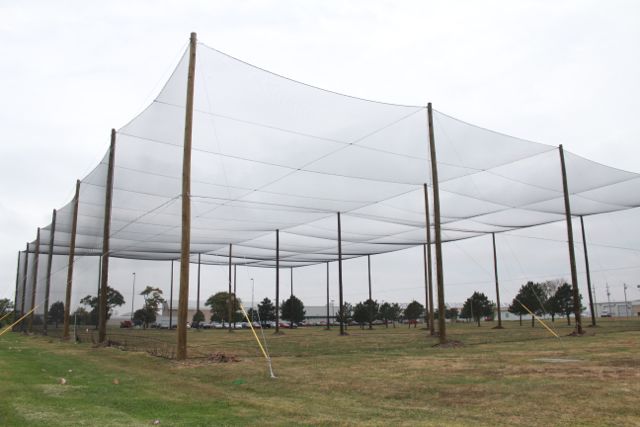October 6, 2015
K-State Salina builds one of the largest enclosed flight facilities for unmanned aircraft systems in the nation

K-State Salina's unmanned aircraft systems, or UAS, program is getting a significant addition with the recent completion of one of the largest enclosed unmanned flight facilities in the nation.
Built in only three weeks during September, the UAS Pavilion measures 300-feet-long by 200-feet-wide and is 50-feet-tall. It will enable both staff members and students to conduct flight training and research within steps of their lab space.
An official ribbon-cutting ceremony for the UAS Pavilion has been planned in conjunction with Westar Energy at 3:30 p.m. Wednesday, Oct. 21, on the K-State Salina campus.
Since the program's inception in 2009, all unmanned aircraft systems flight activities have had to operate offsite because of the campus's proximity to the Salina Regional Airport. According to rules from the Federal Aviation Administration, or FAA, unmanned aircraft — sometimes referred to as drones — cannot fly within five miles of an airport. With unmanned aircraft systems students and staff having to travel to various locations miles away from campus, time and logistics have always presented challenges.
The new UAS Pavilion is located directly next to the UAS Laboratory and was constructed with the assistance of Westar Energy in Topeka. The electric utility company and K-State Salina's unmanned aircraft systems program are partners, collaborating on applied research and training related to the development of unmanned aircraft systems technology in and for the electric power energy sector primarily consisting of infrastructure inspection.
Along with the 25 wooden poles donated and installed by Westar Energy, the facility is completed with golf range netting employed on all sides and across the top. With the structure being contained but not completely closed off to outdoor elements, the facility does not block GPS signals on unmanned aircraft and allows flight missions to be conducted in various weather conditions. Because of the facility's impressive size, on-campus location and multiple applications, the overall efficiency of the program's flight operations and the students' training experience will be increasingly enhanced.
The UAS Pavilion will support unmanned aircraft systems academic programs as well as the research mission of the Applied Aviation Research Center, or AARC. When it comes to research, the unmanned aircraft systems program is committed to a two-fold mission: the first is directly related to the program's core competencies of air vehicle operations, airspace integration and vehicle/payload development; the second part is to serve as an enablement technology for researchers from other disciplines to collect the data they need to complete their analysis without having to deal with the complexities and nuances of aircraft operations.
For assistance with aerial data collection of any kind or to learn more about the UAS Pavilion, contact K-State Salina's interim unmanned aircraft systems program manager, Kurt Carraway, at 785-826-2624 or kcarraway@k-state.edu; or Kurt Barnhart, K-State Salina's associate dean of research and engagement, at 785-826-2972 or kurtb@k-state.edu.
